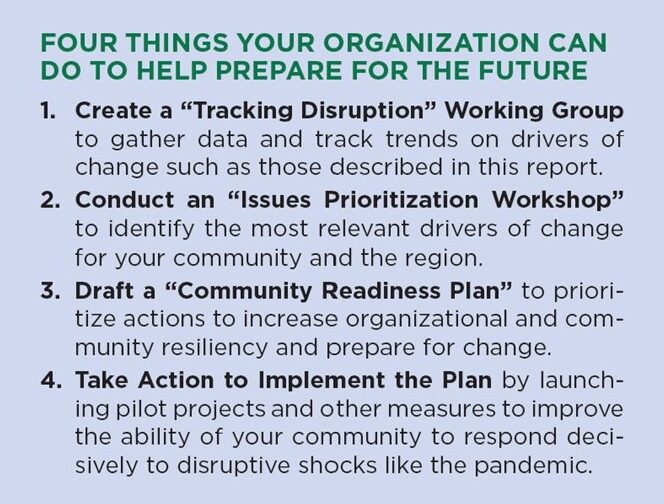This article was originally written for the American Planning Association’s Water and Planning Network newsletter. The photo of Jordan Lake, a primary water source for the Triangle J Region, was taken by Ben Hitchings.
I was pleased to join Lindsay Whitton, Community and Economic Development Director for the Triangle J Council of Governments (TJCOG), and Ben Hitchings, FAICP, Principal of Green Heron Planning, LLC, in a panel session at the 2023 National Planning Conference in Philadelphia. Entitled Taming Disruption: A Case Study in Regional Collaboration, our session explored how TJCOG is helping its member governments in the Triangle J region of North Carolina prepare for the disruptive impacts of change. This article provides a summary of what we covered in the session. While water was not the primary focus, it is an essential resource that cuts across issues and trends that are driving change in today’s world.
The COVID-19 pandemic was a wake-up call for communities and regions. Shocks like the pandemic can force agencies and organizations to change in dramatic ways, while new technologies and other emerging trends are profoundly impacting society and the economy. So, how can we better prepare our communities to successfully manage change? For the last several years, Ben Hitchings and I have been developing an approach designed to help communities do exactly that. Needless to say, we were excited to be asked by TJCOG staff to apply this approach to the Triangle J Region. The goal is to help local governments use strategic foresight – anticipating what will happen in the future in order to make more informed decisions in the present – to deal with the uncertainties of change.
The Triangle J Region encompasses seven counties and 40 municipalities with a 2020 population of just over two million, which is projected to grow to 2.6 million by 2030. It is a diverse region that includes the Raleigh-Durham metropolitan area, the Research Triangle Park, and educational institutions like the University of North Carolina-Chapel Hill, as well as extensive rural and agricultural landscapes. Equity is a primary concern in a relatively prosperous region with increasing socioeconomic inequality (the region’s poverty rate is higher than the national average). Resilience is similarly growing in importance as the region experiences increasing climate change impacts and other stressors associated with change.
Our approach begins with the Drivers of Change framework, which is designed to help communities make sense of the macro-issues and trends that are impacting them now or may impact them in the future. Ben and I organize drivers of change into four categories: social, technological, economic, and environmental. Without getting into the specifics of the framework, two points bear emphasis:
- There are many interconnections between different drivers.
- The challenge for communities is to address them in a proactive, integrated way (rather than the piecemeal, reactive one that is the norm) if they are to successfully prepare for and respond to change.
We worked with TJCOG staff to select 16 drivers – four in each category – based on their importance and relevance to the region (Figure 1). Some (such as housing need and affordability) are well-established. Others (such as economic restructuring caused by the digital economy) have emerged more recently or were magnified by the pandemic. Still others (for example, artificial intelligence) are still emerging, meaning that their impacts will be mostly felt in the future. Water is one of the four environmental drivers selected by TJCOG staff and also intersects with other drivers (for example, climate change and smart cities).

The product of our work was the Triangle Trends Report: Tracking Disruption. Released in fall 2022, the report is organized around the Drivers of Change framework. For each driver, a two-page brief is provided with an overview and implications of the driver; related drivers; considerations for the Triangle J Region; potential responses by local communities and the region as a whole; and key statistics and references, including web links for more information. The potential responses are intended not as definitive recommendations, but rather as initial ideas to stimulate discussion and inform efforts to address change (such as in a strategic planning process). Examples for water include, among others: extending the One Water concept throughout the region; creating a regional water resources dashboard; and tracking thempacts of climate change on regional water sources.

Figure 2. Recommended Next Steps
The report concludes with recommendations for next steps that can be taken to begin preparing for the uncertainty of future change (Figure 2). The key message is that communities and organizations need to incorporate a focus on the future (strategic foresight) into operations, planning, and decision-making if they are to succeed in a world of accelerating, disruptive change.
A copy of the report can be downloaded from the TJCOG website.
